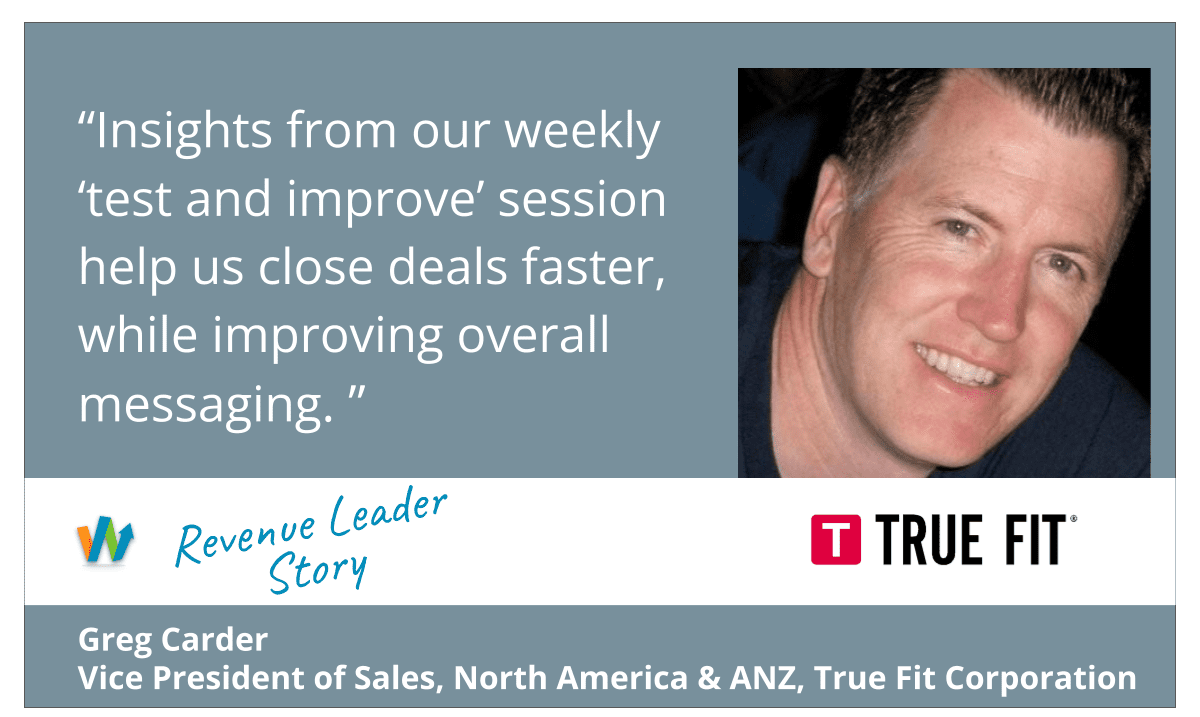 How effectively do you use team-based learning to understand what your buyers value, so you can sell more and sell faster?
How effectively do you use team-based learning to understand what your buyers value, so you can sell more and sell faster?
“We use a weekly ‘test and improve’ session to be more successful in our sales positioning and execution, “says Greg Carder, Vice President of Sales, North America at True Fit. “The insights from these team learning sessions help us close individual deals faster, while also aligning the whole go-to-market team.”
True Fit offers a retail personalization platform to its apparel and shoe retailer customers. The platform provides specific size and style recommendations on more than 17,000 products to the retailer’s end-customers.
In 2021, True Fit hit its annual sales number in the first few weeks of October — almost a quarter ahead of plan! Store and dressing room closures in the pandemic were an obvious boost to True Fit’s business, but that isn’t the only success driver. Greg notes three ways that their team-based learning also helped to drive faster revenue with better sales positioning and sales execution.
Outcome #1: Better Deals
“One of the consistent gaps surfaced during ‘test and improve’ sessions is not knowing enough about the buyer or not having a compelling business event,” Greg says. “In the sessions, there is always a lot of real-time research and discussion focused on improving positioning into buyer value.”
The real-time work in the sessions helps to improve deals, by:
- Identifying a specific hook to anchor True Fit’s value, such as a business initiative identified in an earnings report, a new private label product, or a buyer VIP program
- Suggesting new buyer personas and new value plays to broaden buying engagement, so a deal is not single-threaded with just one internal champion
- Introducing market trend or competitive data to increase a buyer’s urgency to take action
Outcome #2: Real-Time Positioning Feedback
“One of the great outcomes from the ‘test and improve’ sessions is that we get better at positioning across the board,” Greg explains. ”The product and marketing teams hear directly what is resonating with clients and also make direct suggestions for message testing.”
As an example, Greg cites one very big positioning win that was validated during the ‘test and improve’ process. The True Fit team had been historically very focused on fit or style recommendations for individual consumers, until the platform analytics project found general guidance recommendations drove significantly more click throughs than individual recommendations. The ‘test and improve’ process then provided a forum to refine messaging to get retailers excited about the general guidance capabilities.
Outcome #3: Real-Time Coaching Feedback
“The other thing I love about the ‘test and improve’ process is that it acts as an objective source of feedback for individual coaching,” says Greg. “When feedback comes up in a team session, then it is no longer ‘Greg thinks’ — now it is ‘the team thinks’ this is an area for improvement.”
Greg’s team-based coaching helps him to push on skills development, including:
- Did the team member identify clearly enough a key business initiative?
- Did they do the call prep to get to that business initiative?
- How could they do better discovery?
- How well did they build the business case in a later stage deal?
- Could they have pulled on better stories or data?
Top sales and go-to-market teams are different. They understand that practice is the only way to achieve consistent excellence in sales positioning and execution. In the ‘test and improve’ process, Greg and the team at TrueFit commit an hour a week, or 3% of their time, to getting better at their craft. And that hour a week makes all the difference to their performance.
